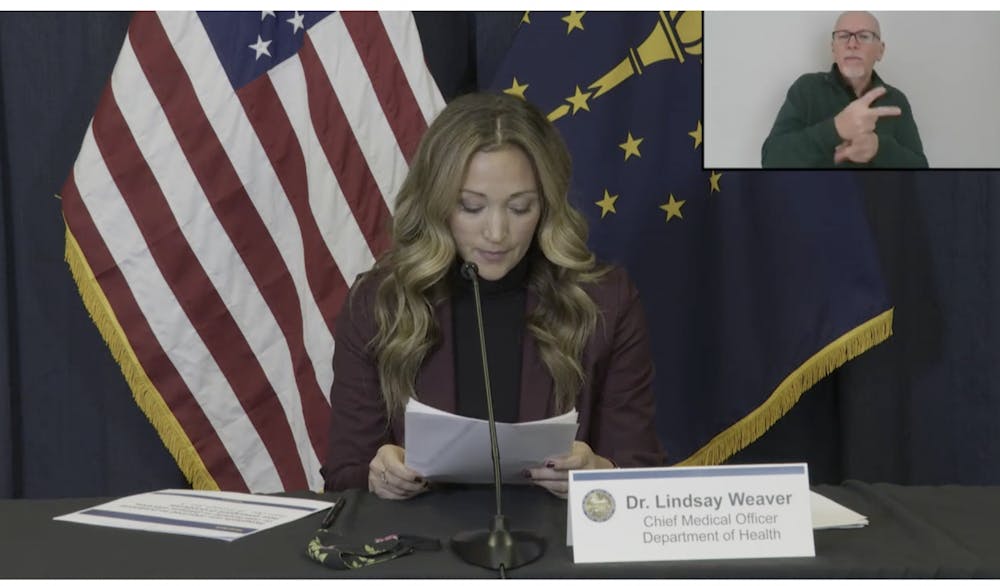Indiana will receive its first supply of the Pfizer vaccine next week and will start administering it to health care workers. The specifics were discussed during Gov. Eric Holcomb’s weekly COVID-19 update.
The state announced it will receive an initial 55,575 doses next week. Holcomb said this was the number they were told they would receive so he wasn’t surprised by it.
“I’d like to have a lot more,” he said. “But I understand we’re dealing with a set volume.”
Along with the information about the first doses to reach Indiana, Holcomb announced a directive that hospitals are expected to postpone or reschedule all non-emergency procedures starting Dec. 16 and going until Jan. 3. This is in response to the rising number of Hoosiers being hospitalized due to the coronavirus and will attempt to lessen the strain on hospital resources.
A Food and Drug Administration subcommittee is expected to approve the Pfizer vaccine Thursday. Indiana State Department of Health Chief Medical Officer Dr. Lindsay Weaver said this is one of the final steps in approving it for emergency use and shipping it to states.
“This is incredibly exciting news because it signals the beginning of the end of this pandemic,” Weaver said.
She noted there is still a long journey ahead. The state estimates that most Hoosiers will receive the vaccine by the summer.
The initial doses expected next week will go to five pilot hospitals, including Clark Memorial Hospital in Jeffersonville, Deaconess Hospital in Evansville, IU Health Methodist in Indianapolis, Community Hospital in Munster and Parkview Health in Fort Wayne. Additional doses are expected to be at 50 more hospitals by the end of next week.
According to information from a Monroe County Health Board meeting last week, the IU Health Bloomington hospital expects to receive about 5,000 vaccines soon.
These hospitals were chosen because they have the “ultra-cold” storage needed for the vaccines and they are spread geographically throughout the state. The vaccines will be shipped in a temperature-controlled way, so facilities will not actually need the cold storage to be able to administer the vaccine.
The first doses will go to frontline workers — such as hospital staff and long-term care facility employees — who are at the highest risk of exposure to COVID-19.
Weaver said there are an estimated 400,000 Hoosiers who can be considered health care workers, including hospital clergy and those who bring food to patients.
“We expect to remain to focus on our health care work force and long-term care residents into January,” Weaver said.
The next to receive the vaccine after frontline workers will be determined by the state vaccine advisory committee and advice from national committees as more is known about the vaccine availability and amounts, Weaver said. The Centers for Disease Control and Prevention’s Advisory Committee on Immunization Practices currently lists essential workers next, Weaver said. She said other experts recognize the importance of vaccinating vulnerable populations next.
“We recognize that many members of vulnerable populations also are essential workers, so we anticipate there will be overlap among the groups when we reach the next phase,” Weaver said.
The vaccine will be given free of charge, but insurance may be billed to offset the administration costs, Weaver said.
For now, those who have had COVID-19 within 90 days may be asked to delay getting the vaccine while there is a small amount, but as more are available, Weaver said everyone will be able to receive a vaccine.
She addressed concerns about safety and effectiveness. The vaccine was 95% effective in trials among adults. People 16 and under cannot get the vaccine yet as there haven’t been trials for children. Weaver said people cannot contract COVID-19 from getting this vaccine and it does not interact with or change DNA in any way.
State Health Commissioner Dr. Kristina Box also addressed the growing number of COVID-19 cases seen in the past weeks. 36 of 92 counties are listed in red, which is more than double the 16 last week.
The recommended social gathering limits that vary depending on the color of the county on the state’s metrics map will be mandated beginning this weekend. That number is 25 people for red counties and 50 for orange counties. Local health departments cannot give exceptions. However, Bloomington’s limit remains at 15 people and was already capped at 25 people for all of Monroe County. Monroe County is currently orange.
“The state of Indiana is on fire,” Holcomb said in reference to the red and orange colors covering the COVID-19 map which indicate counties’ positivity rates.




